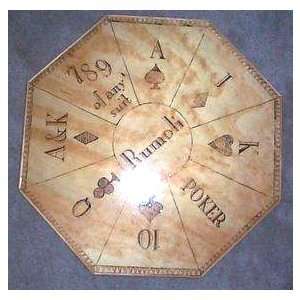Rummoli
Rummoli is a family card game for 2 to 8 people. This Canadian board game, first marketed in 1940 by the Copp Clark Publishing Company of Toronto[1] requires a Rummoli board, a deck of playing cards (52 cards, no jokers), and chips or coins to play. The game is usually played for fun, or for small stakes (e.g. Canadian Dimes). Rummoli is similar to Michigan Rummy.
Rummoli board

A Rummoli board, used during play, has the shape of an octagon. It is generally simply printed on a large sheet of paper.
In the centre of the board is a pot called Rummoli, surrounded by eight pots:
- The poker pot
- Ten of Spades
- Jack of Diamonds
- Queen of Clubs
- King of Hearts
- Ace of Spades
- Ace and King of Diamonds
- Sequence 7-8-9 of any suit
Each of these pots on the board is used to store chips. The ordering of the pots around the board is not important.
Play
Ace is high. For brevity, in the following description the "lowest card" means the lowest card in a player's hand or, if two or more cards are equally low, either or any of them.
A game is played in one or more rounds. The game ends at the end of a round, at the discretion of the players. For example it may be agreed to finish at a certain time, or when all but one player have exhausted their chips.
Rounds
For each round, there are four stages: the Deal, the Poker phase, the Rummoli phase, and the End of round, which are played in sequence. But each round must begin with the 2 of clubs.
A popular variation, particularly when playing with non-poker fans or smaller children, is to play the Poker phase after the "End of Round", thus preventing players from knowing which cards the other players are holding during the Rummoli phase. When the Poker phase is played at the end of the round, the highest poker hand presented wins the pot -- there is generally no bidding (players having already seen each other's cards).
Deal
Before the cards are dealt, each player pays one chip to each pot on the Rummoli board. The dealer then deals around the table to every player, and an extra hand (in some terminology known as a ghost hand) called the widow.
- All cards are dealt, so some players may have one more card than others.
- Once this is completed all players look at their own hands.
- The widow hand can (at the dealer's wish) be swapped with the dealer's hand (it does not matter what the original dealer's hand contains).
- If the dealer does not exchange hands, the widow hand is auctioned off to the highest bidder, who pays their bid to the dealer, and that player exchanges hands with the widow. Any player except the dealer may bid at any time (again, it does not matter what cards are in the bidder's hand. It is a risk anyone can make!)
Once the bid is accepted the player is committed to the exchange regardless if the widow is a poorer hand. The widow hand takes no further part in the play.
Poker phase
- The player to the left of the dealer starts off the betting, having the option to check.
- Betting continues in regular poker fashion. Players may wish to establish a limit prior to starting the game, for example a maximum bet of ten chips, with a maximum of three raises.
- The remaining player with the best poker hand wins the poker pot and lays the lowest card in the hand.
Rummoli phase
While this phase is being played if any player lays down a card corresponding to a pot such as Ace of Spades, the player picks up that pot. However in some forms of the game, if a player places down a card that corresponds to a pot without realizing so, then the chips stay in the pot.
The player with the next card in the sequence of the suit must lay that card, and this continues with players laying cards until nobody has the card that follows in sequence.
- If no one holds that card (that is, it has already been laid or is in the widow hand) the player who last laid a card then lays the lowest card in a suit of the opposite colour (that is, hearts or diamonds if the last card was spades or clubs, and the other way about).
- Having laid an ace the next card in sequence is the lowest card in the opposite colour.
- A player not having a card of the required colour pays one chip into the Rummoli pot and play then moves clockwise. If the next player also cannot play, this step repeats as necessary.[2]
A card once laid takes no further part in the play.
End of round
The first player to have an empty hand wins the Rummoli pot.
- All other players must then pay one chip for each remaining card they hold.
- All pots that are not won remain on the board and accumulate in subsequent rounds.
- The pots for 7-8-9 and Ace and King of Diamonds often accumulate over several rounds, since these combinations are less likely to be held by one player alone, and even if they are, another player may win the round before there is any chance to play them.
The deal shifts after each round, one player clockwise.
End of play
After the agreed end of the round play, all chips on the board are placed into one pot and a round of poker dealt and played for it. A variation is to play a round for each pot that still has chips in it, starting with the pot with the fewest chips.
The player with the most chips at the end of the game wins.